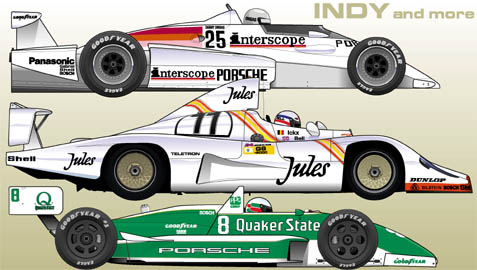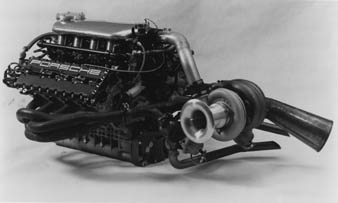Back to Articles
From Speedvision...A Porsche Heritage Story about a Singer creation
 |
||
| Roundabout Route
From Indy to Le Mans, and Back By Andrew Crask |
||
| Sometimes, success in racing comes almost as a matter of
course, as was the case for Porsche with its 956 and 962 prototypes. Other
times, such as with Porsche’s two assaults on the Indy 500 during the 1980s,
the road is long and difficult. But although the original goal—conquering
the Indy 500—went unfulfilled, Porsche added some significant additions
to its big motorsports trophy case through the pursuit.
With the European sports car scene continually beset by political squabbling in the late 1970s, Porsche cast its eyes across the Atlantic to the cornerstone of American motor racing, the Indianapolis 500. It was a natural move, given Porsche’s success with turbocharged engines, which had been predominant at the Speedway for some years. An agreement was reached with the Interscope Racing squad and its dynamic driver, Danny Ongais, to campaign a works-supported Porsche engine in a proprietary chassis that would be built in the U.S. for the 1980 Indianapolis 500 and beyond. Porsche’s first Indy engine was to be a development of the flat-six powerplant originally designed for the 911, built to a capacity of 2.65 liters, the maximum permitted by the regulations. A target of 630hp was defined for the project, and preliminary testing with Interscope’s old Parnelli chassis made that look a realistic goal. Unfortunately, racing politics hamstring Porsche once again, for ’79 was the year of the USAC/CART divorce, which presaged the modern CART/IRL split. Among the many political footballs in the air was the regulated boost level for turbocharged engines, which USAC—still calling the shots for Indianapolis—wanted to reduce in order to promote cheaper production-based powerplants. Less than two months before its planned debut, Porsche had the boost limit of its new engine reduced from 55 to 48 inches of mercury, limiting power to around 500hp. With the rug thus pulled out from under it, Porsche had little option but to withdraw from the program. Designer Roman Slobodjnskj’s innovative ground-effects Interscope chassis was subsequently retrofitted with a Cosworth V8 and, despite minimal testing, proved quite competitive at Indy in Ongais’ hands. Sadly, a huge crash during the race marked the beginning of the end for Ongais’ career and that of his team. Meanwhile, Porsche engineers were determined that their work should not be wasted, and began adapting the Indy engine back to sports car racing. Porsche’s 936 remained a competitive Group 6 design, but its original 2.1-liter motor was no longer competitive. With the capacity expanded to 3.0 liters, the Indy flat six delivered 620hp with solid reliability—just the ticket for Le Mans. Jacky Ickx and Derek Bell were entrusted with a works 936 powered by this engine for the 24 Hours, and crushed all comers to claim their fifth victory at the Sarthe, setting an all-time distance record along the way. Porsche’s fascination with Indianapolis remained, however, and in 1986—prodded
by Al Holbert, now in charge of the company’s North American motorsport
activities—the factory decided to tackle the Indy car arena again, but
this time its plans were even more ambitious: Porsche would campaign both
an engine and a car of its own design.
Recognizing it had significantly underestimated the state of the Indy car chassis art, Porsche opted to park its proprietary chassis for its first full season. Instead, it installed its V8 in a customer March chassis for 1988. Teo Fabi, who narrowly missed the CART title as a rookie five years earlier, was hired to drive the March/Porsche, but results proved disappointing. Fabi’s best finish of the season was a fourth place in the Pocono 500. At Indy, the raison d'etre of the program, Fabi dropped out early with a mechanical failure. Concluding that the unique attributes of the Porsche engine were not well-served by the customer chassis, Porsche forged a special relationship with the British manufacturer for the following season, whereby March would produce a special unique chassis specifically around the German engine. The resultant March 89P proved a much more competitive proposition (although success at Indy remained elusive as Fabi was an early retirement for the second straight year) and Fabi duly claimed Porsche’s first victory, from the pole, at Mid-Ohio. Building on this momentum, the 1990 season should have been the year when it all came together for Porsche. John Andretti joined Fabi in a two-car effort with a radical new carbon fiber monocoque chassis—the first of its kind in Indy car racing. CART, however, was not convinced that the new material was suitable for the sustained high speeds of oval racing (or feared its owners would be forced to build new cars to keep up, depending on your point of view), and forced a last-minute redesign of the March/Porsche 90P in the then-standard aluminum honeycomb construction. The abrupt change—together with an equally innovative but under-developed narrow gearbox—doomed the car to a series of frustrating showings. It was one disappointment too many for Porsche, which decided to end the program at season’s end. So ended Porsche’s brave experiment with open-wheel racing. By objective standards, it had to be considered a disappointment, even allowing for the handicaps imposed by political whim. But the technical capabilities developed along the way helped pave the way for future success as Porsche returned to its sports car racing roots in the 1990s. |
Porsche's
stillborn first Indy program in 1980 (TOP) was born again in the final
iteration of the 936 (MIDDLE). Porsche would finally become an Indy car
winner with its March 89P (BOTTOM). (Illustration by Paul Laguette.)
Porsche Heritage stories |
|

Porsche's V8 Indy engine grew in strength and reliability through its three-year Indy 500 and CART career, but in the end that wasn't enough. |
||
Porsche Motorsport 2000 Home